News Release

Canon Inc.
Tsuzuri Project to donate a high-resolution facsimile of the national treasure Kujaku Myo'o (hanging scroll) to the National Institutes for Cultural Heritage for display at the Tokyo National Museum's "The Door to Japanese Art" exhibit
TOKYO, June 21, 2021—Canon Inc. announced today that the Tsuzuri Project (officially, the Cultural Heritage Inheritance Project), a joint project organized by Canon and the Kyoto Culture Association (NPO), donated a high-resolution facsimile of a "Kujaku Myo'o" (Mahamayuri) (hanging scroll) —the original of which resides in the collection of the Tokyo National Museum—as part of the project's Stage 14. The facsimile was donated to the National Institutes for Cultural Heritage and will be displayed at the Tokyo National Museum from June 22.
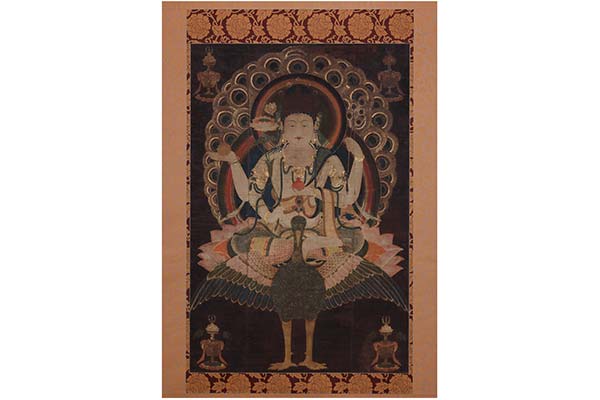
Kujaku Myo'o (hanging scroll)
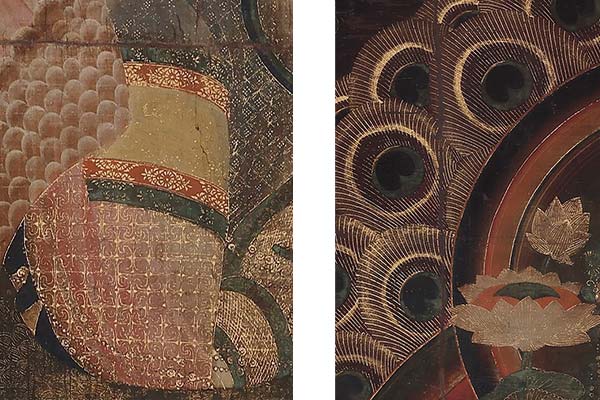
Exquisite use of colors and kirikane metal foil
The national treasure "Kujaku Myo'o" (hanging scroll) is a large (approximately 150 cm x 100 cm) silk work depicting a peaceful Kujaku Myo'o in soft, delicate colors and wearing clothing decorated with kirikane1 metal foil. It is believed to be the only surviving work from Japan's Heian period (794-1185 CE) that features the Kujaku Myo'o, and was created using colors and artistic techniques that flourished during the Insei (cloistered rule) period, making it a highly valuable artifact. In addition, it is the oldest original work that the Tsuzuri Project has handled to date.
In order to minimize the wear on the original work during the high-resolution facsimile creation process, Canon's latest digital imaging technologies and the skills of traditional Kyoto artisans, or takumi, were utilized to produce a facsimile that is highly faithful to the original—including coloring and kirikane that is accurate to within 0.2 mm. Thanks to this donation, the original works can be preserved in more ideal environments while the high-resolution facsimiles can be widely used for public display, allowing more people the opportunity to experience the works in person.
Starting on June 22, the high-resolution facsimile will be displayed at the Tokyo National Museum as part of the new experiential permanent exhibit "The Door to Japanese Art." The exhibit will provide visitors with the chance to see and experience more closely various artistic treasures that have been passed down for generations. Such works are typically displayed behind thick glass casing, but the Tsuzuri Project's high resolution facsimiles can be viewed from up close, allowing visitors, from those unfamiliar with the arts to experienced connoisseurs, to admire the colors and space created by these works of Japanese art.
- 1Kirikane is a technique employed in Buddhist artwork and sculpture that involves the use of thinly sliced gold or silver leaf to create detailed and lavish designs.
- *In order to enter the Tokyo National Museum, visitors must register online in advance. For more information, please refer to the museum's homepage.
About the Tsuzuri Project
The Tsuzuri Project is a social contribution initiative organized by the Kyoto Culture Association and co-sponsored and promoted by Canon with the goal of preserving original cultural assets and creating high-resolution facsimiles. Combining Canon's technical expertise in imaging, processing and output with the master craftsmanship of traditional Kyoto artisans, the Project produces and donates high-resolution facsimiles of such celebrated historical Japanese cultural assets as folding screens, sliding doors and illustrated scrolls. As of the Project's Stage 11, begun in 2018, the camera and lens equipment used in the process of creating the high-resolution facsimiles have been upgraded2.
The Project began in 2007 with two objectives—to donate high-resolution facsimiles of Japanese art abroad to their original owners, and to create high-resolution facsimiles of historical cultural assets that appear in school textbooks for use as tangible educational materials to teach primary and secondary school students about Japan's history, art and culture. Different works from artists including Katsushika Hokusai, Tawaraya Sotatsu and Ogata Korin, have been selected every year since, with 57 facsimiles donated to date.
For more information, please visit the official Tsuzuri Project website.
URL:https://global.canon/en/tsuzuri/
- 2As of Stage 11, the Project utilizes a Canon EOS 5D Mark IV digital SLR camera and EF 400mm f/2.8L IS II USM lens. As of Stage 12, the Project utilizes an imagePROGRAF PRO-4000 large-format printer.
The Tsuzuri Production Process
Input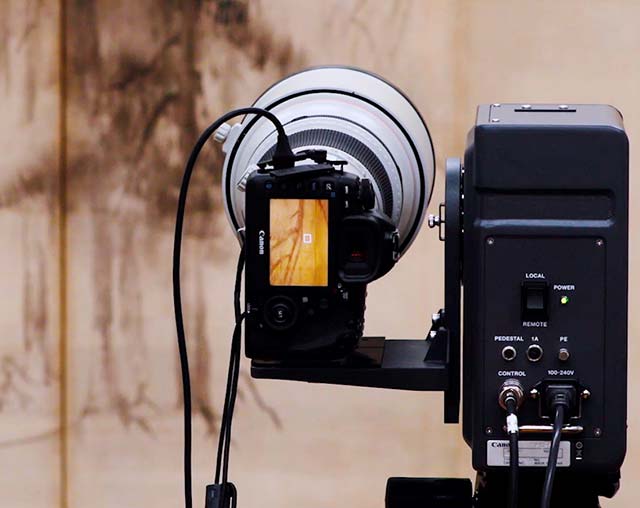 |
Capturing high-resolution digital dataA digital SLR camera is used to capture high-image-quality data for output in the actual size and dimensions of the original cultural artifact. The camera is mounted on a specially designed turntable, enabling it to capture segmented portions of the original work, which are then digitally stitched into a single high-resolution image file. |
Color matching |
Highly accurate color matching systemThe high-resolution data is digitally processed using Canon's proprietary color matching system, which corrects for inherent differences in the lighting environment where the work was photographed. The image is printed and colors are matched on location, helping to minimize both technicians' workload and the wear on the original cultural artifact. |
Output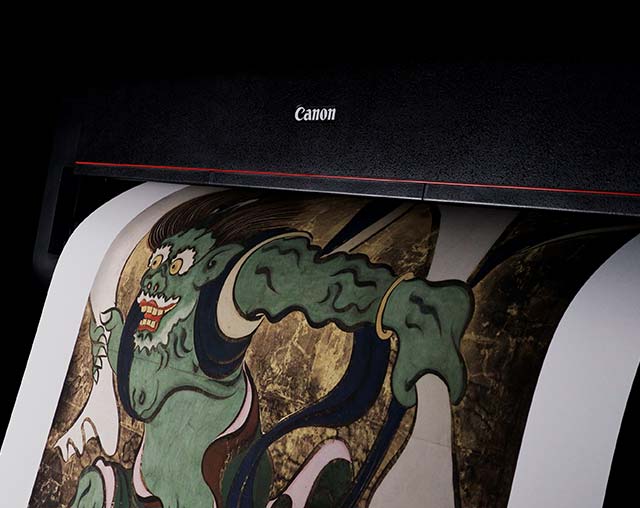 |
World's highest level of printing technologyJapanese art expresses a dimensional depth through its delicate tonal subtleties and shading. These are recreated using Canon's imagePROGRAF large-format inkjet printer, which outputs the data onto washi or silk paper that we have specially designed to be ideally suited for printing facsimiles of the cultural artifacts and applying such finishes as gold leaf. |
Gold leaf, gold paint & isinglass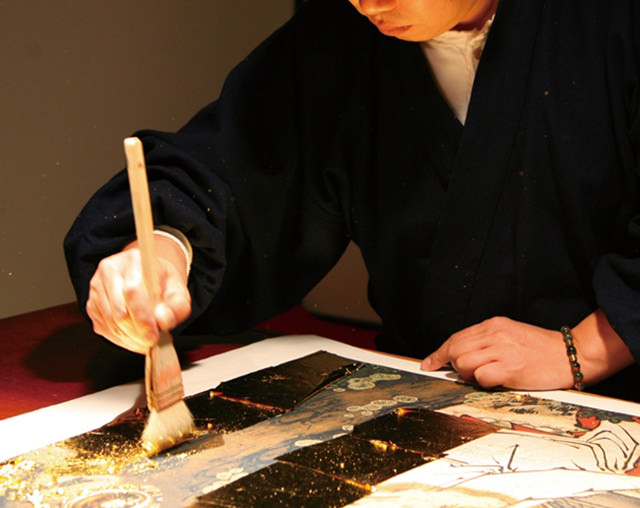 |
Reproduced through time-honored and traditional techniquesAuthentic Kyoto Nishijin craftsmen reproduce the most significant features used in Japanese cultural artifacts—gold leaf, gold paint and isinglass. Special "color fading" techniques recreate the effects that time has had on the gold leaf. |
Mounting |
A discipline developed in KyotoA master Kyoto framer carefully mounts the output and finished facsimile using traditional Japanese tools. Great care is taken to recreate fading in the metalwork and fabric used in folding screens, while sliding door panels are installed exactly as they were in their original locations. |
- *Learn more about the Canon technologies used to create high-resolution facsimiles of cultural treasures in this video on the Canon website:
https://global.canon/en/v-square/76.html
About "The Door to Japanese Art"
- Name
- The Door to Japanese Art
- Overview
- A permanent exhibit opening on Tuesday, June 22, at the Tokyo National Museum. The concept entails visitors opening a "doorway" into an interactive exhibit in which they can experience Japanese art. The room beyond the "doorway" holds a wealth of cultural treasures for visitors to enjoy.
The exhibit comprises three areas:
- See <Visuals of Japanese culture>
- Enjoy <Digital timeline of Japanese artwork>
- Feel <High-resolution facsimiles of Japanese art> (artwork on display will change depending on season)
- Time
- 9:30 – 17:00
- Closed
- Mondays (except national holidays, in which case the museum will be closed on the following Tuesday)
Tuesday, December 14, 2021
New Year Holidays (12/26/2021 - 1/1/2022)
Tuesday, January 4, 2022
Other unscheduled closings1
- Venue
- Tokyo National Museum (Room T3, Honkan)
13-9 Ueno Park, Taito-ku, Tokyo
- Admission
- Admission for Tokyo National Museum Regular Exhibitions
Adults: 1,000 yen
University Students: 500 yen
High/Junior High/Elementary School Students and persons under 18: Free
*Visitors must pre-register for museum access online1
High-resolution facsimiles, including works created by a joint research project between Canon and the National Center for the Promotion of Cultural Properties2, will be on display in the "Feel" area of the exhibit: "Kujaku Myo'o" (hanging scroll)3 and "Wind God and Thunder God / Flowering Plants of Summer and Autumn" 4. In addition, the important cultural properties "Wind God and Thunder God" (Ogata Korin) and "Flowering Plants of Summer and Autumn" (Sakai Hoitsu) are both pairs of two-fold screens and feature the same imagery on both sides of the screen. Currently, the front and back sides of the originals have been separated in order to facilitate preservation in storage. The high-resolution facsimiles have been produced according to their original configuration, allowing them to be viewed from either side.
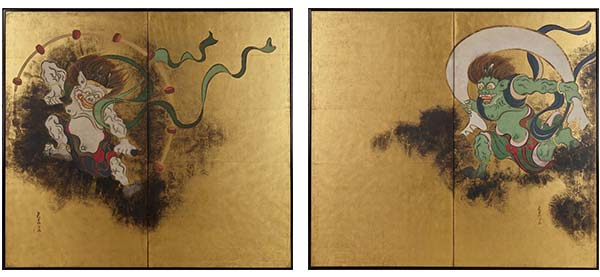
Important Cultural Property "Wind God and Thunder God" by Ogata Korin (the originals of which reside in the collection of the Tokyo National Museum)
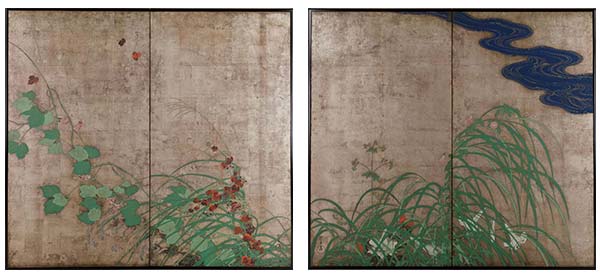
Important Cultural Property "Flowering Plants of Summer and Autumn" by Sakai Hoitsu (the originals of which reside in the collection of the Tokyo National Museum)
- 1For more information, please visit the Tokyo National Museum homepage. In addition, please be aware that entry to the museum requires registration online in advance.
- 2Since 2018, Canon and the National Center for the Promotion of Cultural Properties have been collaborating on a joint research project for the creation of high-resolution facsimiles of important Japanese works of art using technology employed by the Tsuzuri Cultural Inheritance Project (Tsuzuri Project) jointly administered by Canon and the non-profit Kyoto Culture Association, and will continue cooperation on research and testing to develop new applications for such technology.
- 3The high-resolution facsimile of "Kujaku Myo'o" (hanging scroll) will be on display until the end of March 2022.
- 4The high-resolution facsimiles of "Wind God and Thunder God / Flowering Plants of Summer and Autumn" will be on display until Sunday, August 29, 2021.
